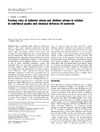Identificador persistente para citar o vincular este elemento:
https://accedacris.ulpgc.es/handle/10553/410
| DC Field | Value | Language |
|---|---|---|
| dc.contributor.author | Caballero Ortega, Pascual | en_US |
| dc.contributor.author | Granado Reyes, Inmaculada | en_US |
| dc.date.accessioned | 2009-10-08T02:31:00Z | - |
| dc.date.accessioned | 2018-03-01T13:36:40Z | - |
| dc.date.available | null | - |
| dc.date.available | 2018-03-01T13:36:40Z | - |
| dc.date.issued | 2001 | en_US |
| dc.identifier.issn | 0025-3162 | en_US |
| dc.identifier.other | 856 | - |
| dc.identifier.other | WoS | - |
| dc.identifier.uri | https://accedacris.ulpgc.es/handle/10553/410 | - |
| dc.description.abstract | Algae frequently suffer attack by herbivores and in some cases complete destruction has been observed. Despite the role of herbivores in structuring marine algal communities, herbivore food choice and the algal traits that herbivores use to choose foods are poorly documented. There has been much discussion and disagreement regarding the best method of assessing food preference. Experiments designed to detect preferential feeding involve offering a selection of food types to one or more individual consumers. Ideally, the potential foods are presented simultaneously to the consumer within a single experimental arena so that the consumer has the opportunity to express a dietary choice. However, some experimental designs allow individual consumers to feed for a constant time on individually presented alternative foods, which permits comparisons of feeding rates on these different foods. Such an experiment is not a true feeding preference experiment because no food choice is provided, but the results can reflect differences in attractiveness or palatability of various potential foods that may also be expressed when choices are offered. In this work,''discrimination" in selection of algae was tested in two invertebrate species common on intertidal rocks in Gran Canaria (Littorina striata and Osilinus atratus) by measuring their feeding rates on 20 common algal species in no-choice laboratory experiments. The algae represented the major floral elements of the local intertidal community. L. striata and O. atratus exhibited high feeding rates on Enteromorpha muscoides and Ulva rigida, whereas Alsidium corallinum and Laurencia corrallopsis were refused. The majority of algal species were readily consumed by these two generalist herbivores. No clearly defined trends in the concentrations of ash, nitrogen, carbon, soluble carbohydrates, soluble proteins, and caloric content in the seaweeds were found to account for these differences in feeding rates. In contrast, feeding rates varied according to the presence of secondary metabolites. The low susceptibility to grazing by snails in the least-consumed algae seems to be associated with the presence of secondary metabolites. We suggest that feeding rates of L. striata and O. atratus on algae are primarily due to avoidance of algal chemical defenses, whereas positive aspects of food quality probably play a lesser role in determining consumption. | en_US |
| dc.language | eng | en_US |
| dc.relation.ispartof | Marine Biology | en_US |
| dc.source | Marine Biology [ISSN 0025-3162], v. 138 (6), p. 1213-1224, (Junio 2001) | en_US |
| dc.subject | 241705 Biología marina | en_US |
| dc.subject.other | Algas marinas | en_US |
| dc.subject.other | Ecofisiología | en_US |
| dc.subject.other | Burgados (Gasterópodos) | en_US |
| dc.title | Feeding rates of Littorina striata and Osilinus atratus in relation to nutritional quality and chemical defenses of seaweeds | en_US |
| dc.type | info:eu-repo/semantics/article | en_US |
| dc.type | Article | en_US |
| dc.identifier.doi | 10.1007/s002270100544 | en_US |
| dc.identifier.scopus | 0034938531 | - |
| dc.identifier.isi | 000169576700015 | - |
| dc.contributor.authorscopusid | 6506784785 | - |
| dc.contributor.authorscopusid | 36884069000 | - |
| dc.contributor.contentdm | Organismos, poblaciones y ecosistemas | - |
| dc.contributor.contentdm | Biología | - |
| dc.contributor.contentdm | Facultad de Ciencias del Mar | - |
| dc.identifier.absysnet | 239285 | - |
| dc.identifier.crisid | - | - |
| dc.identifier.eissn | 1432-1793 | - |
| dc.description.lastpage | 1224 | en_US |
| dc.identifier.issue | 6 | - |
| dc.description.firstpage | 1213 | en_US |
| dc.relation.volume | 138 | en_US |
| dc.investigacion | Ciencias | en_US |
| dc.rights.accessrights | info:eu-repo/semantics/openAccess | - |
| dc.type2 | Artículo | en_US |
| dc.contributor.daisngid | 28217864 | - |
| dc.contributor.daisngid | 2725442 | - |
| dc.description.numberofpages | 12 | en_US |
| dc.utils.revision | Sí | en_US |
| dc.contributor.wosstandard | Organismos, poblaciones y ecosistemas | - |
| dc.contributor.wosstandard | Biología | - |
| dc.contributor.wosstandard | Facultad de Ciencias del Mar | - |
| dc.contributor.wosstandard | WOS:Granado, I | - |
| dc.contributor.wosstandard | WOS:Caballero, P | - |
| dc.date.coverdate | Enero 2001 | en_US |
| dc.identifier.supplement | - | - |
| dc.identifier.ulpgc | Sí | en_US |
| dc.contributor.buulpgc | BU-BAS | en_US |
| dc.description.jcr | 1,473 | - |
| dc.description.jcrq | Q1 | - |
| dc.description.scie | SCIE | - |
| item.fulltext | Con texto completo | - |
| item.grantfulltext | open | - |
| Appears in Collections: | Artículos | |
SCOPUSTM
Citations
43
checked on Jun 8, 2025
WEB OF SCIENCETM
Citations
39
checked on Feb 25, 2024
Page view(s)
86
checked on Sep 7, 2024
Download(s)
121
checked on Sep 7, 2024
Google ScholarTM
Check
Altmetric
Share
Export metadata
Items in accedaCRIS are protected by copyright, with all rights reserved, unless otherwise indicated.
